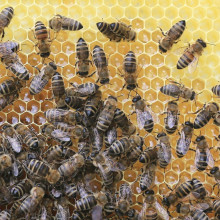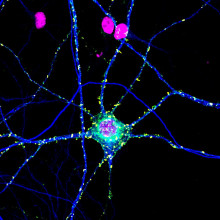This week, we’ll find out about preparations for the next pandemic and "disease X"; the link between a noticeably enlarged part of the human brain and obesity; and how honey sweetened the deal for an injured cricketer!
In this episode

00:49 - Prepping for the next pandemic
Prepping for the next pandemic
Dr Bassam Hallis
"We say Covid was the biggest public health incident for a century, but I don't think any of us think it'll be a century before the next." The words of Prof Dame Jenny Harries, chief executive of the UK’s Health Security Agency who have this week launched a new laboratory to halt the next pandemic in its tracks. It’s called the Vaccine Development and Evaluation Centre, and will be focusing on tackling current threats - like bird flu and superbugs - as well as disease ‘X’, the next potential threat to public health. Dr Bassam Hallis is the lab’s Deputy Director at the site in Porton Down…
Bassam - With climate change, with urbanisation, we do expect to see more public health emergencies, and some of those inevitably will lead to pandemics. And what we hope from having those facilities is ensuring we do as much work as possible, currently in what we call 'at peace time'. So we are ready to respond faster and at a higher capacity in order to actually provide a quick response, which hopefully will reduce the ability of the next virus from causing the pandemic or the public health emergency that we've had during covid.
Chris - So if COVID started now that the centre is being established, what would you do differently? That would mean we were more agile, we were faster off the mark against COVID. And how would it affect outcomes?
Bassam - Because of the learnings we've had from COVID, because of the new facilities, we are able to respond and mount a response that is significantly faster and higher capacity. So to give you an idea, one of the key assays, the tests we were doing to demonstrate the efficacy of the vaccines against COVID. When COVID started, we were testing about 100 samples a week. With the new facilities we have and the increase in our scientists, we are now able to test 3000 samples a week. We are now able to have significantly bigger responses, much faster to provide the data to the policy makers on which vaccine to deploy, and also the vaccine developers to allow them to develop the vaccines and get them licensed.
Chris - Prevention's always better than cure though. And if we're at a stage where we're now having to test things, it means the threat's already here. So is an element of the work going to be better international collaboration and communication to try to keep the threats out and at bay in the first place so that we don't end up with a pandemic spreading from one geography all over the world and then becoming a major threat everywhere?
Bassam - Absolutely. And collaboration, both within the UK and globally, is absolutely key to the response. You know, we feel we have fantastic capabilities and excellent scientists to respond to any public health emergency, but nobody could do it on their own. And that's why we work very closely with academic partners and with industry and NGOs, whether that's in the UK or globally. We are constantly performing surveillance studies in this country to see what might be coming up, what might be happening. At the same time we work with partners internationally, so to try and identify any potential emerging new virus or bacteria and try to get hold of them and do the work we need to do to try and stop them from causing the public health emergency pandemic that SARS COV-2 virus managed to do.
Chris - One of the theories about where COVID came from was that it may have been an escape from a laboratory, accidental or otherwise. If you are talking about bringing deadly things to your laboratories, how do we know that we're not going to have an outbreak from port and down?
Bassam - So our facilities, Chris, are unique in being able to handle those pathogens, those bacteria and viruses that are categorised according to the level of how dangerous they are. And we are uniquely placed in being able to receive those pathogens to grow them and work with them safely. We meet all the requirements that are required to work with these pathogens, whether from safety or from security.
Chris - So you will be bringing potentially things like Ebola to your laboratories in order to work on things of that sort of threat level in order to work out how to mitigate them?
Bassam - Absolutely. And Ebola is an example that we've done that for. When there is a potentially emerging virus or bacteria, the only way we could respond is to get hold of these, bring them here into our laboratories, and work with them safely and securely to try and understand how they cause disease, how they transmit between people or indeed whether they're likely to transmit from an animal to a person like what we're doing now with influenza. And then to put all the tools necessary. So we are ready from day one to evaluate any new vaccines or therapeutics should we need to deploy this.
Chris - Flu is going to be one of those ever present threats, which you must have your eye on COVID obviously, because it's still very much in evidence at the moment. But what other things are you worried about at the moment? What are going to be the targets now for the years ahead that you're going to be either working on or doing active surveillance on?
Bassam - We have a very active surveillance program that happened, you know, ongoing in this country. One of the things we're doing is to make sure our capability and our preparedness is pathogen agnostic. And what I mean by that, while we maintain surveillance programs to be clear about what may be circulating in our country or potentially coming into our country, is developing the capabilities that allow us to respond, what we call 'disease X'. And what I mean by that is whatever could come up, so the capabilities we are developing and enhancing, the increase in the scientific knowledge that we have here is really being targeted to respond to whatever comes up next.

06:60 - Hypothalamus size linked to obesity
Hypothalamus size linked to obesity
Stephanie Brown, University of Cambridge
The hypothalamus – the region that sits on the underside of the brain – as well as controlling things like sleep, body temperature, blood pressure and how thirsty we feel, also plays a key role in hunger. And researchers have discovered that it's noticeably larger in people who are overweight. Stephanie Brown from the Department of Psychiatry at Cambridge University conducted the research…
Stephanie - This study was focused on looking at brain structure in the context of body mass index. So as you mentioned, we know that a large number of factors influence how we eat and the types of food we eat, including genetics and hormone regulation and our environment. But we also know that this region called the hypothalamus sits at the base of the brain. It's about the size of an almond, and it plays a really important role in telling us when we're hungry and when we're full. So what we actually found is that when we did a large number of brain scans, the volume of the hypothalamus was significantly larger in people who were overweight and people who were living with obesity. And what we also saw is this significant relationship between volume of the hypothalamus and body mass index. And going down to further detail, these volume differences were really most apparent in the smaller regions of the hypothalamus that control appetite through the release of hormones to balance hunger and fullness.
Chris - Do we know whether this is cause or effect? People have done studies on other parts of the brain, the London taxi driver study most famously where if you look at London taxi drivers who have to learn all of the streets of London, you find that one region of the brain concern with navigation, the hippocampus, is much larger in those taxi drivers and we think that it gets larger because it's the sort of use it and lose it phenomenon. So do you think it's that overeating enlarges your hypothalamus or do you think an enlarged hypothalamus causes you to overeat? Which way do you think the equation runs?
Stephanie - Yeah, so this is really the really important next question. In this research, we need to understand whether this change in the structure of the hypothalamus is a cause or a consequence. The reason we are thinking it might be a consequence is that in animal studies we see a high fat diet can cause inflammation of the hypothalamus, which in turn prompts insulin resistance and obesity. And this can actually happen really quickly. So in just three days of a high fat diet, we see this localised inflammation in animal models. So if what we see in mice is the case in humans, then a high fat diet could trigger localised inflammation of our appetite control centre. And over time, this would potentially change our ability to tell when we've eaten enough and then how our body processes blood sugar leading us to put on more weight.
Chris - Why would the inflammation occur and why would inflammation cause a change in how we process calories and how we choose to eat more of them?
Stephanie - Yeah, so that's a very good question. The answer is quite complicated because there's a lot of factors involved. But as a first step, we know that when we eat a high fat diet that can cause inflammation in the body, things like c-reactive protein, for example. And when these inflammatory processes happen, this can infiltrate the brain. And then what we know from this process in animal models is that the brain's localised immune cells, these are called glia, can increase in size. So what we think we are seeing is a reflection of this inflammatory process at a localised level in the hypothalamus.
Chris - While we've got you, Stephanie, can I ask you about one other paper I spotted this week in the Journal of Clinical Nutrition where researchers said that they reckoned that eating a handful of nuts every day was associated with about a 17% drop in your risk of depression. What do you make of that?
Stephanie - I think we always have to be really careful when we look at studies to not over-interpret the information that's being presented. So we know there's also a lot of lifestyle factors that can come into this as well. But from a biological point of view, it could be plausible. And that's because we know that nuts have anti-inflammatory properties and we know that inflammation in the body, whether this be through inflammatory disease stress or even obesity these things can be a risk factor for depression via this inflammatory process. So if we take this evidence together, it is possible that nuts might be a protective food to eat against depression because they may counteract inflammatory processes. But really much more research would be needed in that area to be able to draw any conclusions about that.

12:44 - Healing honey and haemorrhoid leeches
Healing honey and haemorrhoid leeches
Sophie Goggins, National Museums Scotland
England cricketer Moeen Ali - “the beard that’s feared” - has credited an NHS worker with helping heal an injured finger after she sent him a ‘wonder’ gel made from honey. It came as a surprise to many - including the spin bowler himself - that the golden stuff can be used to help heal wounds, but the practice dates back earlier than even the ancient Egyptians. Sophie Goggins is senior curator of biomedical science at National Museums Scotland…
Sophie - We don't know exactly the first time honey was used medicinally. But we have some really early recorded examples in Sumerian clay tablets from around 6,200 BC and also examples in Egyptian papyrus about using honey to treat wounds and also sore throat. But historic use of honey has kind of been seen across the entire globe. From Greece to the Romans, to the Mayans, to Babylon.
Chris - Do we know what they were doing with it and were all those practices roughly the same?
Sophie - They may not have known why exactly honey was helping, but they certainly knew that honey was helping to heal wounds. So we now have the benefit of knowing that honey is an anti-inflammatory and antibacterial and also has the great benefit of it provides a damp or, I know people hate this word, but moist environment for wounds to heal, which actually helps them speed up healing and less likely to scar, which are both things that are recorded of honey being used to treat wounds.
Chris - So they would've smeared it on when they had some kind of laceration or some kind of penetrating injury. Honey would've just gone on, almost out of the jar.
Sophie - <laugh> Yes. I think out of what I imagine were quite beautiful jars and what maybe we call today a poultice also in something that people might remember or recognize also being used in hot water with citrus to help with a sore throat.
Chris - Did they document why they thought it might be working or were they just comfortable with the fact that this appears to work, we'll just use it.
Sophie - Writing about medicine of that time is very much more like an instruction manual. They're not giving us a lot of insight into why they thought things, but what they would use to treat certain diseases. I should also say some from that time are a little bit less helpful than our honey example.
Chris - I mentioned leeches in the introduction because that's the other one that's got a little bit of ick factor, but also is a great story in the telling and it really works. Plastic surgeons use leeches to get the blood out of bits of tissue that otherwise would suffer from what we call venous congestion. So we know that this is the real deal that also has a rich history, doesn't it?
Sophie - Yeah. So there's examples of leeches depicted in tombs from ancient Egypt around 1400 BC but a particular record I like is a medicinal record from 50 AD by Pliny the Elder, which recommended leeches to be used for treating haemorrhoids, which I imagine would work but would be quite an experience.
Chris - Quite uncomfortable, I should think. <laugh>. Wow. I'm not really sure what to ask off the back of that. But again, did they use them consistently? Because we know that it works in the modern era when we are putting bits of the body back together because the problem isn't getting blood into tissue, it's that the blood gets in and can't get out. So surgeons tend to light leeches because they'll draw the waste blood away from tissue, which means more fresh blood goes in. Did our ancient historical ancestors know about this sort of practice or were they just doing it because it seemed again, a bit magical and occasionally someone got better so they thought, well let's do this.
Sophie - Well, Galen of the four humours fame was a big fan of leeches in order to balance the humours so people remove blood from the body. But I would say they hit peak popularity, if you can, in around the 19th century for the same type of thing, just to remove blood
Chris - <laugh> But not haemorrhoids that time?
Sophie - You'd hope not. <laugh>.
Chris - Are there any other examples of things a bit like leeches from history where you can find that there's actually quite a long history of its use, but it turns out to be quite a valid treatment and is this still in use today?
Sophie - Yeah, so one that springs to mind is cloves and clove oil, which have been used in dentistry for hundreds of years and before that in traditional medicine. So clove oil's kind of cool and contains a chemical called eugenol, which might help decrease pain and also fight infection. So it's why you often are told to rub clove oil on a wound in your mouth, but that chemical is actually used in dental preparations for stealing root canals and also for pain control.
Chris - Amazing. We know that people are increasingly getting interested in folklore remedies and, and they're going and talking to indigenous people about indigenous solutions to various diseases, and that's how a number of new medicines have been 'discovered', in inverted commas. Are any projects underway to datamine historical text to look for lost treatments or lost antidotes to various things so that we can discover things in writing rather than just currently in use?
Sophie - Ooh, I don't know, but I absolutely love that idea. I always say as a curator, I love people looking to history and the idea of people looking to history books could always be a great starting point or inspiration for any research project.

17:59 - What causes the Perseid meteor shower?
What causes the Perseid meteor shower?
Diana Hannikainen, Sky and Telescope Magazine
It’s that time of year when the Perseid meteor shower, an annual celestial event eagerly awaited by skywatchers around the world, makes its appearance, peaking just before dawn on Sunday, August 13th, when observers might see one meteor per minute. But what are we actually seeing? Diana Hannikainen is from Sky and Telescope Magazine…
Diana - The Perseids is a meteor shower. And meteor showers are what are commonly called shooting stars. They're not really stars. In fact, they are little particles of dust and debris left behind by the passages of comets when they come into the inner solar system. Comets are far out in the outer edges of the solar system, and every now and then one of them comes close to the sun. And in doing so it starts to shed material, leaving behind bits of it. And when the earth passes through the stream of rubble left behind some of these comets, then what we see is a display of meteors.
Chris - Why, just at this time of year, because this happens around this time every year. So why is it just in this patch of our solar system?
Diana - This happens to be where the earth's orbit around the sun intersects with previous passages of the comet. And this particular comet that gave rise to the Perseids is known as Swift-Tuttle. Swift and Tuttle were two people who first discovered the comet in 1862, just a couple of days apart. And every August the earth happens to cross where the comet has passed in the past.
Chris - So has it left this debris trail just floating in space. And periodically our orbit crosses it. And that's why we get this display in the sky at this time of year?
Diana - Correct. After it comes through, after the comet comes through and comes into the inner solar system, it leaves behind a rather thin trail of gas and dust behind it. But with time, this trail spreads out, but it's always in the same place. The comet has a fairly steady orbit, and it follows the same trajectory.
Chris - It's in an orbit, this comet, why does it not cross our orbit twice? Why do we only see one meteor shower per year from this comet?
Diana - That is an excellent question, and that is because the orbit of this comet is not in the same plane as the earth and the other planets. It is tilted. You can picture it as zipping in from above and going below the plane of the orbit of the planets before heading back out into the outer reaches of the solar system. So it sort of comes in at an angle.
Chris - And the particles that it's left behind, how big are they? What do they look like?
Diana - They're really little specks of dust, grains of sand. If you go to the beach and you grab a fistful of sand, there are some really tiny little bits of sand in there. There are some slightly bigger ones. None of the particles is bigger than let's say a small pebble. And in fact, a lot of people think that the rubber left behind by comets comes just from what we see as the tail when comets approach the sun. But in fact, the comet, if you think of it as a dirty snowball, a little ball of ice that comes in from the outer reaches of the solar system, it is subjected to a lot of stress and strain. And so what happens is it cracks and there are these little fissures on the surface, and it's bits of pieces of the comet that come out of there that then form the debris trail.
Chris - It's extraordinary though that something as tiny as that can produce such an amazing firework display.
Diana - Oh, absolutely. And the reason it does that is because these particles hit the atmosphere, the upper atmosphere, at tremendous speeds. They're coming in really, really fast. The Perseids specifically, the speeds of the particles have been measured at around 200 times the speed of a jet plane. They are slamming into the atmosphere and they're releasing a lot of energy that way. And that is what we see as these beautiful streaks and trails in the night sky.
Chris - Now, talking of things incoming, it's a bit ironic, isn't it, that we heard the report this week that NASA had this DART mission. The idea being to see if we could fend off something that was bigger than a grain of sand. If a big asteroid were coming in. For example the DART mission was all about firing a projectile at something deep in space and deflecting it. And it was announced this week that this experiment has been a success. They've slammed an impactor into an object, but it has unfortunately led to the creation of a whole load of potential impactors now.
Diana - Yes, that's a real oopsie specifically because as you've said, the whole point of the mission was just to test this scenario - 'Can we blow up an asteroid?' In this case, it was the moonlet of an asteroid. Can we direct an explosive across space to such a focused target? And like you said, all of that was successful. So it's incredibly ironic to hear now that yeah, maybe some of that is heading towards us.
Chris - <laugh> Do we know when it might arrive?
Diana - I'm not sure about that, but I don't think it will be anytime too soon. I think we'll all enjoy meteor showers, the regular meteor showers before we start to see any of that.

23:32 - Why does my left brain control my right side?
Why does my left brain control my right side?
Will - When we describe someone as having a twisted mind, we probably don't mean it literally, but this is the case for humans and other vertebrates. Some bundles of neural pathways crossover in the central nervous system. So the right side of the brain controls the left side of the body. In evolution, most useful stuff sticks around. And if these twists are in so many species of vertebrate, that means either every vertebrate evolved separately, convergent evolution, or more likely it developed right at the start of the existence of vertebrates. So that answers the octopus question straight away. They aren't vertebrates and so don't have the twist. In fact, most of their neurons are in their tentacles. So when and why did this twisting of our nerves take place? Well, for a long time, the most widely accepted explanation came from Spanish neuroscientist Ramon y Cajal. And here to explain it is the University of Münster's Marc de Lussanet.
Marc - In 1899, the famous Spanish neuroscientist Ramon y Cajal proposed that the crossed brain has a direct evolutionary advantage for vision through the pupil. The light projects an inverted image on the retina of each eye.
Will - So since the retina takes a flipped image, the twist is necessary in order to flip it back. Makes sense. However, this theory isn't without its critics, including Marc himself.
Marc - Unfortunately, though, Cajal's explanation doesn't work. Since the optic radiation inside the brain follows a loop, thus turning the image around.
Will - So no need to flip an image twice then. So what could be the reason for the twist? Well, perhaps the answer lies in the evolution of vertebrates themselves. When backbones first started evolving, they were on the ventral side of the body, which is to say the tummy side. Now imagine your spine going down your front. Actually don't do that. But as vertebrates evolved, the spine moved towards the back, and in doing so, may have twisted, almost wrapping the nerves around with it. This is the somatic twist hypothesis. Mark has another idea too, called the axial twist hypothesis.
Marc - According to this alternative line of explanation, the forebrain that is cerebrum and thalamus, along with the anterior part of the head, is turned around entirely. So not only left and right, but also front and back are reversed. In the early embryo just three to four weeks after gestation, this occurs by opposite asymmetric growth and leads to a complete twist. This involves not only the nervous system, but the entire body. Accordingly, the facial region, eyes, nose, and mouth grows from the left side to the midline and the ears, spine and limbs grow in the opposite direction around your body axis. Only the heart and bowels retain their original orientation and thus end up really asymmetrically.
Will - So an embryo's brain develops asymmetrically and causes the twist by being slightly lopsided.
Marc - In fact, careful observers can see the remnant of asymmetry in other people's faces. The right side of the face is larger than the left side, especially in babies and young children.
Will - The biological rationale of these two hypotheses would therefore be the spine is better off at the back and the twisting of the nerves don't seem to do any harm. The conversation is still ongoing though, so don't put your back out waiting for an answer. Thanks to Donald for the question, and Marc de Lussanet for the help with the answer. If you have a scientific quandary of your own, send it in to chris@thenakedscientists.com.
Related Content
- Previous What holds atoms together?
- Next Q&A: Knuth, curry and kettles










Comments
Add a comment